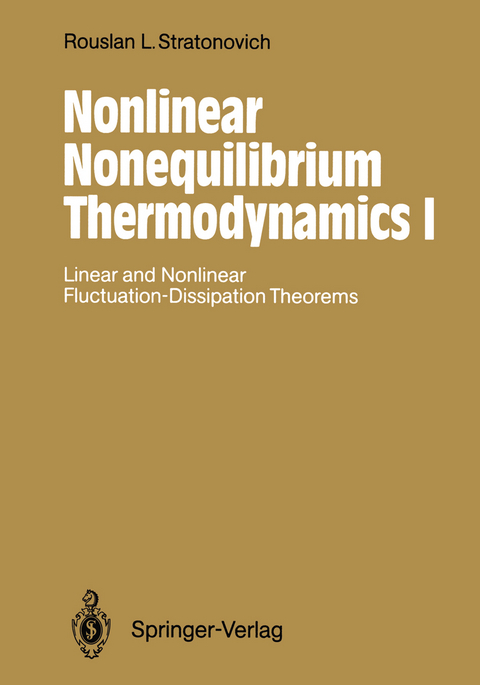
Nonlinear Nonequilibrium Thermodynamics I
Springer Berlin (Verlag)
978-3-642-77345-7 (ISBN)
1. Introduction.- 1.1 What Is Nonlinear Nonequilibrium Thermodynamics?.- 1.2 Early Work on Nonlinear Nonequlibrium Thermodynamics.- 1.3 Some Particular Problems and Their Corresponding FDRs: Historical Aspects.- 2. Auxiliary Information Concerning Probability Theory and Equilibrium Thermodynamics.- 2.1 Moments and Correlators.- 2.2 Some Results of Equilibrium Statistical Thermodynamics.- 2.3 The Markov Random Process and Its Master Equation.- 2.4 Infinitely Divisible Probability Densities and Markov Processes.- 2.5 Notes on References to Chapter 2.- 3. The Generating Equation of Markov Nonlinear Nonequilibrium Thermodynamics.- 3.1 Kinetic Potential.- 3.2 Consequences of Time Reversibility.- 3.3 Examples of the Kinetic Potential and of the Validity of the Generating Equation.- 3.4 Other Examples: Chemical Reactions and Diffusion.- 3.5 Generating Equation for the Kinetic Potential Spectrum.- 3.6 Notes on References to Chapter 3.- 4. Consequences of the Markov Generating Equation.- 4.1 Markov FDRs.- 4.2 Approximate Markov FDRs and Their Covariant Form.- 4.3 Application of FDRs for Approximate Determination of the Coefficient Functions.- 4.4 Examples of the Application of Linear Nonequilibrium Thermodynamics Relations.- 4.5 Examples of the Application of the Markov FDRs of Nonlinear Nonequilibrium Thermodynamics.- 4.6 H-Theorems of Markov Nonequilibrium Thermodynamics.- 4.7 Notes on References to Chapter 4.- 5. Fluctuation-Dissipation Relations of Non-Markov Theory.- 5.1 Non-Markov Phenomenological Relaxation Equations and FDRs of the First Kind.- 5.2 Definition of Admittance and Auxiliary Formulas.- 5.3 Linear and Quadratic FDRs of the Second Kind.- 5.4 Cubic FDRs of the Second Kind.- 5.5 Connection Between FDRs of the First and Second Kinds.- 5.6 Linear and Quadratic FDRs of the Third Kind.- 5.7 Cubic FDRs of the Third Kind.- 5.8 Notes on References to Chapter 5.- 6. Some Uses of Non-Markov FDRs.- 6.1 Calculation of Many-Time Equilibrium Correlators and Their Derivatives in the Markov Case.- 6.2 Examples of Computations of Many-Fold Correlators or Spectral Densities and Their Derivatives with Respect to External Forces.- 6.3 Other Uses of Nonlinear FDRs.- 6.4 Application of Cubic FDRs to Calculate Non-Gaussian Properties of Flicker Noise.- 6.5 Notes on the References to Chapter 6.- Appendices.- A1. Relation of Conjugate Potentials in the Limit of Small Fluctuations.- A2. On the Theory of Infinitely Divisible Probability Densities.- A2.1 Justification of the Representation (2.4.9) Subject to (2.4.10).- A2.2 Example: Gaussian Distribution.- A3. Some Formulas Concerning Operator Commutation.- A5. The Contribution of Individual Terms of the Master Equation.- A6. Spectral Densities and Related Formulas.- A6.1 Definition of Many-Fold Spectral Densities.- A6.2 Space-Time Spectral Densities.- A6.3 Spectral Density of Spatial Spectra and Space-Time Spectral Density.- A6.4 Spectral Density of Nonstationary and Nonhomogeneous Random Functions.- A7. StochasticEquations for the Markov Process.- A7.1 The Ito Stochastic Equation.- A7.2 Symmetrized Stochastic Equations.- References.
| Erscheint lt. Verlag | 16.12.2011 |
|---|---|
| Reihe/Serie | Springer Series in Synergetics |
| Zusatzinfo | XVI, 361 p. |
| Verlagsort | Berlin |
| Sprache | englisch |
| Maße | 170 x 242 mm |
| Gewicht | 655 g |
| Themenwelt | Mathematik / Informatik ► Informatik ► Theorie / Studium |
| Naturwissenschaften ► Physik / Astronomie ► Thermodynamik | |
| Schlagworte | fluctuation-dissipation theorems • Nonequilibrium Thermodynamics • Nonlinear Systems • Statistical Physics • thermodynamics |
| ISBN-10 | 3-642-77345-1 / 3642773451 |
| ISBN-13 | 978-3-642-77345-7 / 9783642773457 |
| Zustand | Neuware |
| Haben Sie eine Frage zum Produkt? |
aus dem Bereich


